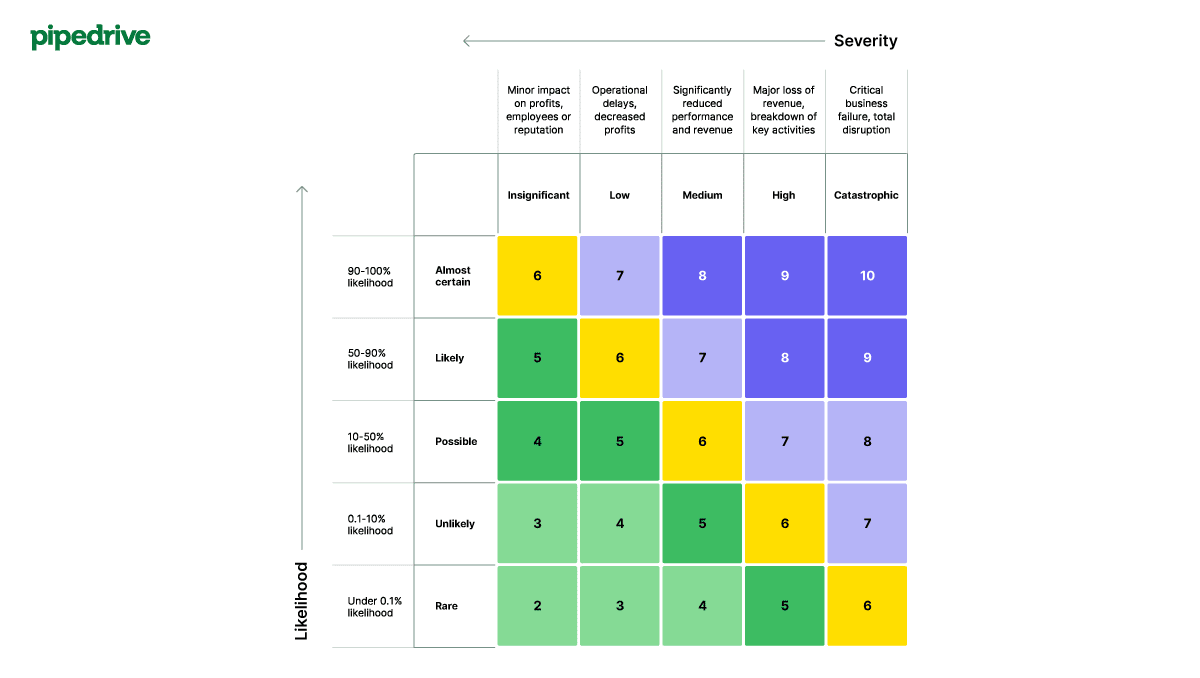Our view at Stack - Pipedrive is a robust CRM platform, offering automation, contact data collection, webhooks, AI-powered sales assistant, email communications, email marketing, and customisable sales pipeline workflows.
Companies face unexpected disruptions all the time. Whether it’s a natural disaster, cyberattack or a simple power outage, these can affect business operations and cut into profits.
A solid business continuity plan (BCP) helps you foresee and mitigate these risks, keeping your business running.
In this article, we’ll explore what a business continuity plan is and why it’s so important. We’ll also provide a BCP template and a step-by-step guide to create your own continuity plan.
What is a business continuity plan?
A business continuity plan outlines how your company can maintain operations during a disruptive event. Its goal is to reduce downtime and data loss, ensuring that your business can return to normal functioning fast.
For example, imagine a regional retail chain faces a sudden flood in its main distribution center. Since the center is in a flood-prone area, the chain had previously prepared a business continuity plan with guidance on what to do if a flood occurs.
Using its BCP, the retailer reroutes its deliveries through secondary warehouses, contacts emergency suppliers and launches a task force to manage the logistics.
A rapid, organized response like this minimizes disruption and maintains inventory flow so the company can keep running.
Recommended reading

Everything you need to know about small business management
Why is business continuity planning so important?
A business continuity plan keeps your company going during unexpected events. However, it’s not just about recovering downtime; it’s also about safeguarding employees’ and customer expectations.
Disruption happens. Any responsible business should have risk management to protect its profitability and people.
Here are some examples of how business continuity planning can be useful:
-
Minimize downtime. A BCP ensures that your company can keep running when interruptions happen, protecting the business from a significant hit.
-
Ensure quick recovery. A BCP has detailed procedures to restore your company’s normal functions quickly. Having these procedures in place means you don’t need to spend time working out what to do.
-
Protect revenue. BCPs prevent serious financial losses by helping the company get back on its feet faster.
-
Maintain customer confidence. A BCP ensures you can still deliver your services, helping retain customer loyalty during a crisis.
-
Comply with regulatory requirements. Some industries are legally required to have BCPs.
-
Protect employee welfare. BCPs include ways to keep employees safe during a crisis. For example, they should contain clear evacuation procedures and remote team management options in case a natural disaster occurs.
A business continuity plan can protect against a wide range of problems. However, to do so, they need to be thorough. Let’s take a look at what a business continuity plan looks like.
Recommended reading

How Your Sales Team Can Handle a Global Financial Crisis
We’ve put together a business continuity plan template to use as a starting point when crafting your BCP which you can request below.
Keep in mind that there’s no one-size-fits-all business continuity plan. You may need to add and remove sections from the template to create one that works for your company.
In the next section, we’ll explain each part of the BCP template, why they’re important and what they should contain. Then, we’ll provide actionable advice you can use to put together an effective BCP.
Download your free business continuity plan template
Prepare your own business continuity plan using this free spreadsheet
6 key components of a business continuity plan
Business continuity plans have multiple key sections. They typically start by analyzing risks and impacts, followed by detailed strategies to respond to different scenarios. They also include emergency contact information, roles and responsibilities and training plans.
Here are the key components of a business continuity plan.
1. Business continuity plan overview
The first section of a BCP should provide an overview of the document. It should introduce the BCP’s purpose and provide information to help people understand and navigate the document quickly and easily.
It should cover:
-
Introduction. Briefly explain what the BCP is for and why it’s important.
-
Objectives. State the primary goals of the BCP, like maintaining operations and reducing downtime.
-
Scope. Define the plan’s scope, including what departments and types of disruptions it covers.
-
Assumptions. Include any key assumptions made during the planning process, such as available resources.
-
Plan activation. Explain what conditions or scenarios would trigger the BCP.
-
Document structure. Outline the document and explain each main section.
-
Approval and authority. List key individuals or positions with authority over the BCP during an emergency.
-
Review and maintenance. Outline who is responsible for reviewing, updating and maintaining the BCP.
This overview section sets the stage for the rest of the BCP, clarifying its purpose, scope and management.
2. Communication plan
A BCP should include an up-to-date contact list of employees, contractors, clients and stakeholders.
The communication plan aims to enable a rapid and coordinated response. It helps you save time finding contact information like phone numbers or email addresses.
This section may also include specific guidance for:
It should define each person’s contact details and the communication channels to use if there’s a disruption.
Full contact details allow a company to quickly notify people and departments affected by a disruptive event. They can also set up communications for response teams through email, messaging apps and other channels.
3. Business impact analysis
A business impact analysis (BIA) identifies your company’s critical functions and outlines the maximum downtime each function can take before harm occurs.
This section aims to determine which functions your business needs and doesn’t need so that you can focus your efforts in the right places in an emergency.
For example, a small business’s impact analysis might look like this:
| Function | Impact |
| Order processing | Impact: Loss of sales revenue
Max downtime: 2 hours |
| Website operations |
Impact: Loss of customer access
Max downtime: 4 hours |
| Customer support | Impact: Decrease in customer satisfaction
Max downtime: 8 hours |
4. Risk assessment
The risk assessment section identifies threats to your business. It ties in with the business impact analysis, showing each threat’s potential impact and likelihood.
The risk assessment also considers disruptions such as natural disasters, cyberattacks, data breaches, pandemics and power outages. It should include a description of the risk, its likelihood, impact and strategies to prevent it from occurring.
The goal is to be as thorough and realistic as possible, highlighting the most likely risks to your company.
Here’s an example:
| Risk | Likelihood, Impact and Strategy |
| Cyberattacks (e.g., hacking, malware) | Likelihood: High
Mitigation strategy: Antivirus software, security audits and team training |
| Website downtime | Likelihood: Moderate
Mitigation strategy: Establish a backup hosting provider |
| Natural disaster | Likelihood: Low
Mitigation strategy: Emergency response plan, business insurance |
5. Recovery plan
The BCP details recovery strategies for each potential business impact. If something affects one of your critical functions, the BCP explains the actions, resources and the amount of time needed to get it running again.
You can also include recovery actions in the same section as the business impact analysis, but this can be too much information in one place. Separating these sections lets you provide more detail and organize the information in an easier-to-read way.
Here’s what a small company’s business recovery strategy might look like:
| Critical Business Activity | Recovery Actions and Requirements |
| Order processing |
Recovery actions: Use backup payment gateway, use manual order processing
Recovery Time Objective: 1 hour |
| Website operations | Recovery actions: Switch to a backup hosting provider, implement cybersecurity measures
Resource requirements: Backup hosting provide, IT personnel for hosting management Recovery time objective: 2 hours |
| Customer support |
Recovery actions: Provide support on social media, use alternative phone systems Resource requirements: Social media account, alternative phone systems Recovery time objective: 4 hours |
For larger, more complex organizations, this section is split into key departments or impact categories.
For example, a company might create different sections for information technology (IT), sales and marketing impacts. It might also organize impacts by their criticality, listing catastrophic impacts first and less important ones later.
6. Testing and training
BCPs are only effective if they’re kept relevant and employees know what to do in a crisis. To keep the BCP up-to-date, include a testing and training section that outlines drills, training programs and periodic reviews.
It might include:
-
Descriptions of regular drills and exercises that can test how effective the BCP is
-
Training programs about employees’ roles and responsibilities in a disruption
-
Review schedules and key stakeholders who will maintain the document
Here, you can also note when and where training and reviews occurred. It outlines the reason for training or review, what took place and who was responsible.
Recommended reading

7 best management styles for effective leadership
How to create a business continuity plan
Now that you know the key components of a business continuity plan, you can determine which sections are relevant to your business and create your plan.
Here’s a step-by-step guide to creating a BCP for your company.
1. Organize a team
Creating a detailed business continuity plan is a big task. To put one together, you’ll need the help of key employees across your organization. The bigger your company, the more people you’ll need to involve.
If you own a small business, you might not need a business continuity team. You might assign the role to a single senior employee or even yourself.
Here’s how to put your team together:
-
Identify the team leader. Choose a business continuity manager to oversee the process. Ensure the person is detail-oriented and understands what to do in a crisis.
-
Select team members. Choose representatives from each department to evaluate risks and recovery plans for their work area. Ensure to include someone from each operational area, such as IT systems, human resources, legal, etc.
-
Organize a kick-off meeting. Schedule the first meeting where you’ll introduce the purpose of the team. Define each person’s role and responsibilities, establish a crisis communication plan and create working groups to start on the BCP.
Some companies bring in external consultants and experts to provide guidance and develop the plan. It’s worth considering whether you’ll need expert help. It can be expensive but might help you create a more comprehensive, foolproof continuity plan.
2. Establish objectives and deadlines
Before you start the business continuity plan, clearly list your goals and deadlines.
Creating a BCP is a big job, and it’s easy to put it off or spend too much time on specifics. A clear project management timeline helps you guarantee that you can deliver it on time.
Here’s a business continuity plan example timeline:
| Stage | Goals and Milestones |
| Initial assessment | Goal: Conduct a business impact analysis and risk assessment Milestone: Complete assessment within 4 weeks |
| Strategy development | Goal: Create recovery strategies for key business functions
Milestone: Approve strategies within 8 weeks |
| Plan drafting | Goal: Draft detailed procedures in the final document Milestone: Complete draft within 12 weeks |
| Review and approval | Goal: Get feedback from key stakeholders and refine the plan
Milestone: Get approval within 14 weeks |
| Training and testing | Goal: Train staff and begin regular drills
Milestone: Conduct the first training session within 16 weeks |
You can break each stage down further into specific, measurable goals. For example, for the strategy development milestone, you might set deadlines for each department based on how much work they need.
3. Conduct a business impact analysis
A business impact analysis lists all of your business’s functions. It tells you which business activities are critical and what would happen if they were disrupted. It also explains how long your company could survive without performing the activity.
Here are four things you need to conduct a business impact analysis.
List all of your company’s functions and processes
Conduct interviews with department heads and ask them to give you an overview of their processes.
List every business activity. The bigger your company is, the longer this list will be.
Work out which functions are critical
Critical functions are those that your company cannot exist without. From your interviews, try to understand how each department works and the potential threat of disrupting their activities.
Try to estimate the resources each function needs and how likely they are to fail.
Analyze the impact
Assess the impact of disruptions on each business function and rate them as low, medium, high or catastrophic.
Use criteria like downtime, financial loss, reputation damage and customer experience to inform your rankings. Share your final list with each department to ensure nothing’s missing.
Set recovery time objectives (RTOs)
RTOs are the maximum time each function can be down before significant damage happens.
Consider how quickly you should restore each function to ensure continued operations. Define each time frame, focusing on the critical business functions first.
To create an effective BCP, your business impact analysis needs to be accurate and detailed. Take your time to establish precise impacts and recovery times before moving to the next step. The more realistic your analysis is, the better your recovery plan will be.
Note: Some business impact analyses include recovery point objectives (RPOs). RPOs define the maximum data loss your company can handle, helping you determine how often you should back up data. To define your RPOs, you must determine how important each function’s data is to your company’s operations based on its sensitivity and role.
4. Perform risk assessments
Risk assessments help you find the biggest threats to your company. They show you which risks could cause the business impacts identified in the last step.
To perform a risk assessment, ask yourself:
-
What could cause each business impact?
-
How serious would the impact be?
-
How likely is it to happen?
-
Can you reduce or prevent the risk?
First, identify all risks facing your company, including internal risks (e.g., equipment failures, data breaches and employee error) and external risks (e.g., natural disasters, cyberattacks and supply chain problems).
Once you have a list of risks, determine their severity and likelihood. Use a risk matrix to prioritize risks (low, medium or high) based on likelihood and impact.
Consider historical data, industry reports and statistics to determine their likelihood. To analyze the impact, consider the financial loss, disruption, legal consequences or reputation damage it would cause.
Here’s a template risk matrix you can use to define risk and likelihood:

Finally, work out if you can take any preventative measures to stop high-priority risks from occurring.
For example, you might use cloud-based backup systems to protect your data from cyberattacks.
5. Create recovery strategies
Recovery strategies are the steps you take to return your company to normal. You can develop strategies for each scenario based on your risk assessments and business impact analysis. If the worst happens, you’re prepared to overcome the problem.
Here’s what to do:
-
Develop specific recovery plans. For each critical function, outline specific actions and resources required to recover it. Make sure outlines are detailed, clear and actionable.
-
Assign roles and responsibilities. Designate employees to execute each part of the strategy. Make sure key roles have backups in case employees are affected by the disruption.
-
Note resource requirements. For each recovery plan, note the resources needed for success. For example, if your recovery plan involves temporarily running your website from a backup server, you’ll need the backup server before disruption occurs.
-
Establish the timeframe for recovery. Based on your business impact analysis, decide on a realistic timeframe to implement your recovery plan.
Once you have a recovery plan for each critical business function, contact your team leaders again for feedback. Make sure each risk management plan is realistic and actionable.
Test each plan in controlled environments to find gaps or unclear instructions that could lead to further problems.
6. Draft the plan
Once you have all that information, it’s time to draft your business continuity plan. Use the business continuity plan sample template we’ve provided to give yourself a head start or begin with the basic structure of a BCP:
Be clear and concise so that team members can easily understand the document. Avoid unnecessary jargon and use tables, flowcharts and checklists where possible. These elements make complex information easier to digest, especially in an emergency.
Note: Every company is different, and you can box yourself in by sticking to a BCP template too closely. Take some time to consider your company in detail. Is there anything you need to include that isn’t in the template? Add it. Is there anything in the template that doesn’t apply to your company? Remove it.
7. Train employees and drill for unexpected events
You must train your employees and regularly test your recovery plans for your business continuity plan to be effective. The first step is to distribute your BCP (as hard and digital copies) to all employees, making it as easy to access as possible.
Once they’ve read it, you could:
Use orientation sessions to introduce the BCP to your employees
Provide an overview of the document and explain why it’s important to the company.
Seek initial feedback and gauge how effective your first draft is and if you need to make any changes.
Provide one-on-one training sessions for key employees
In these sessions, focus on their role during an unexpected event or emergency. Schedule regular refreshers to keep the continuity plan fresh.
Run tabletop sessions to roleplay important scenarios
Plan exercises where you can walk through scenarios in a controlled environment.
Get team members to roleplay and practice recovery procedures in real time. Look for gaps in the plan and places for improvement.
Schedule drills for emergency protocols
Drills can help people remember what to do in an emergency. They’re particularly useful regarding crisis management, evacuation procedures or staying in touch with employees and stakeholders following an event.
8. Review and test the plan periodically
Companies change constantly, whether it’s new employees, different contractors or different business activities. You should keep your business continuity program up-to-date with these changes to ensure it’s still effective.
Create a schedule where you test and review your business continuity strategy, updating information as you go.
How frequently should you test and update your BCP?
-
Perform small tests (like data backup tests) every quarter
-
Conduct more comprehensive drills or tabletop sessions twice a year
-
Every year or two years, consider a full-scale emergency response simulation
-
Do a complete review after any significant change to your company, like changes in staffing or company restructuring
It’s also important to track industry trends. Stay informed about new risks and business continuity best practices and adjust the BCP to align with important changes.
If you keep your continuity plan up-to-date and fresh in your employees’ minds, you’ll ensure an agile response if anything goes wrong.
Business continuity plan FAQs
Final thoughts
Creating a robust business continuity management plan ensures your business can withstand unexpected disruptions. By identifying risks, conducting a business impact analysis and creating targeted strategies, you can keep your business afloat no matter what happens.
Ready to take your business preparedness to the next level? Try Pipedrive’s 14-day free trial and see how our CRM can streamline your business management processes and keep your operations running smoothly.
If Pipedrive is of interest and you'd like more information, please do make contact or take a look in more detail here.
Credit: Original article published here.
